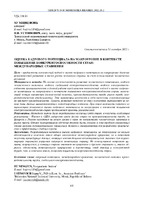| dc.contributor.author | Ху Минцзюнь | ru |
| dc.contributor.author | Устинович, И. В. | ru |
| dc.coverage.spatial | Пинск | ru |
| dc.date.accessioned | 2024-01-13T10:01:32Z | |
| dc.date.available | 2024-01-13T10:01:32Z | |
| dc.date.issued | 2023 | |
| dc.identifier.citation | Минцзюнь, Ху Оценка кадрового потенциала на макроуровне в контексте повышения конкурентоспособности стран: международные сравнения = Aassessing human resource at the macro level in the context of enhancing country competitiveness: international comparisons / Ху Минцзюнь, И. В. Устинович // Экономика и банки. – 2022. – № 2. – С. 68-77. | ru |
| dc.identifier.uri | https://rep.bntu.by/handle/data/139174 | |
| dc.description.abstract | Цель – предложить комплексный подход к оценке кадрового потенциала на макроуровне (наличие возможностей развития и точек роста экономики страны за счет использования человеческих ресурсов). Материалы и методы. На основе изучения индекса развития человеческого потенциала, индекса человеческого капитала, индекса глобальной конкурентоспособности, индекса конкурентоспособности промышленности в данной работе предлагается комплексный подход к оценке кадрового потенциала на макроуровне в контексте повышения конкурентоспособности стран, включающий четыре параметра (человеческий капитал, производительность труда, рынок труда, макроэкономическая стабильность). Эти параметры включают в себя элементы, сгруппированные по признаку принадлежности. Уровень развития каждого из этих элементов оценивается на основе базы данных вышеупомянутых международных индексов. При этом важность каждого их параметров показателя оценки кадрового потенциала на макроуровне в контексте повышения конкурентоспособности стран предлагается принять равнозначной. Результаты. Методика оценки была апробирована на данных ряда стран, и получены следующие результаты - Япония и США лидируют среди других стран по производительности труда, но Беларусь и Россия находятся на одном уровне с ними по показателям человеческого капитала и рынка труда. Однако корпоративное обучение должно быть усилено, и это требует совместных усилий органов государственного управления, бизнеса и университетов для разработки практических и эффективных учебных курсов. Заключение. Разработанная методика оценки кадрового потенциала на макроуровне не только обеспечивает в конечном итоге общее комплексное международное сравнение, но и позволяет получить процедурные данные, которые имеют большее исследовательское значение для корректировки стратегии развития кадрового потенциала страны. Их использование позволяет выявить направления, в которых страна отстает по сравнению с другими странами и, таким образом, обозначить потенциальное направление и перспективы этой страны в конкурентной борьбе, что, в конечном итоге, позволит повысить конкурентоспособность стран. | ru |
| dc.language.iso | ru | ru |
| dc.publisher | Полесский государственный университет | ru |
| dc.title | Оценка кадрового потенциала на макроуровне в контексте повышения конкурентоспособности стран: международные сравнения | ru |
| dc.title.alternative | Aassessing human resource at the macro level in the context of enhancing country competitiveness: international comparisons | en |
| dc.type | Article | ru |
| local.description.annotation | The purpose of the study. an integrated approach to the assessment of human resources potential at the macro level (availability of development opportunities and growth of the country's economy through the deployment of human resources) is proposed. Materials and methods. On the basis of a study of the human development index, the human capital index, the global competitiveness index, and the industrial competitiveness index, this paper proposes a comprehensive approach to the assessment of human resource potential at the macro level in the context of improving the competitiveness of countries, including four parameters (human capital, labor productivity, labor market, macroeconomic stability). These parameters include elements grouped on the basis of affiliation. The level of development of each of these elements is evaluated on the basis of the database of the aforementioned international indices. Thus importance of each of their parameters of an indicator of an estimation of personnel potential on a macrolevel in a context of increase of competitiveness of the countries it is offered to accept equivalent. Results. The evaluation methodology was tested on the data of a number of countries and the following results were obtained - Japan and the USA are leaders among other countries by labor productivity, but Belarus and Russia are at the same level with them by human capital and labor market indicators. However, corporate training needs to be strengthened, and this requires joint efforts of public administration, business and universities to develop practical and effective training courses. Conclusion. The developed methodology for assessing human resource potential at the macro level not only ultimately provides an overall comprehensive international comparison, but also provides procedural data that are of greater research value for adjusting the country's human resource development strategy. Their use makes it possible to identify areas in which the country lags behind compared to other countries and, thus, to indicate the potential direction and prospects of this country in the competition, which will ultimately improve the competitiveness of countries. | en |

